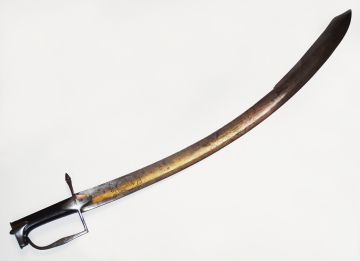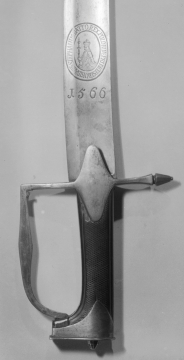Explore Collections


You are here:
CollectionsOnline
/
Sabre, inscribed with the date 1566
Browse
Sabre, inscribed with the date 1566
Steel
Inscription: STEPHANUS BATTO, REX POLONIAE, PRINCEPS TRANSILVANIAE
Inscription: 1566
Museum number: MP22
Not on display
Curatorial note
This style of sword is called a 'coffin-hilt' and began appearing in Britain in the late 1780s, arming some British light dragoon cavalry regiments and some yeomanry cavalry regiments. The hilt can be found in a variety of designs of which this one is typical. The design is said to have been influenced by the weapons of Austrian and Hungarian hussars (along with British cavalry sword designs of the 1790s). The main maker associated with this kind of hilt is the famous Thomas Gill but without his mark on the sword we cannot say for certain that he made it.
The 1837 'AB' Soane Museum inventory describes this sword as: A Sabre with an effigie round which is the following inscription "STEPHANUS BATTO, REX POLONIAE, PRINCEPS TRANSILVANIAE 1566" . This is a reference to Stephen Báthory (1533-1586), King of Poland (1576-86) and Prince of Transylvania (1576-86). He was a member of a Hungarian noble family and in 1576, married Queen Anna Jageillon of Poland and became the third elected King of Poland, co-ruling with his wife. He was particularly successful militarily, defeating a number of rebellions and repulsing an attempted Russian invasion led by Ivan the Terrible. He is buried in Krakow Cathedral. The unidentified 'effigie', a mark within the inscription on the blade, is of a king holding an elaborate orb and sceptre. It is not related to the coat of arms of Stephen Báthory but may be intended to represent him.
The blade's engraving is interesting but it is unlikely that the date refers to the blade's year of creation. Perhaps the date points to a significant event although it is before Bathory became King of Poland. The engraving is perhaps a later, commemorative decorative addition commissioned by a patriotic owner? The blade could certainly be older than the hilt but without a maker's marking it is impossible to say.
This would be rather a short, heavy blade for a horseman's sword as they always preferred long blades so this sword was probably intended to be carried on foot.
We are grateful to Matthew Forde of Forde Military Antiques for his help with this entry.
The 1837 'AB' Soane Museum inventory describes this sword as: A Sabre with an effigie round which is the following inscription "STEPHANUS BATTO, REX POLONIAE, PRINCEPS TRANSILVANIAE 1566" . This is a reference to Stephen Báthory (1533-1586), King of Poland (1576-86) and Prince of Transylvania (1576-86). He was a member of a Hungarian noble family and in 1576, married Queen Anna Jageillon of Poland and became the third elected King of Poland, co-ruling with his wife. He was particularly successful militarily, defeating a number of rebellions and repulsing an attempted Russian invasion led by Ivan the Terrible. He is buried in Krakow Cathedral. The unidentified 'effigie', a mark within the inscription on the blade, is of a king holding an elaborate orb and sceptre. It is not related to the coat of arms of Stephen Báthory but may be intended to represent him.
The blade's engraving is interesting but it is unlikely that the date refers to the blade's year of creation. Perhaps the date points to a significant event although it is before Bathory became King of Poland. The engraving is perhaps a later, commemorative decorative addition commissioned by a patriotic owner? The blade could certainly be older than the hilt but without a maker's marking it is impossible to say.
This would be rather a short, heavy blade for a horseman's sword as they always preferred long blades so this sword was probably intended to be carried on foot.
We are grateful to Matthew Forde of Forde Military Antiques for his help with this entry.
Literature
Charles Martyn, The British Cavalry Sword from 1600, 2004 [general source]
Brian Robson, Swords of the British Army, 2011 [general source]
Brian Robson, Swords of the British Army, 2011 [general source]
Soane collections online is being continually updated. If you wish to find out more or if you have any further information about this object please contact us: worksofart@soane.org.uk




